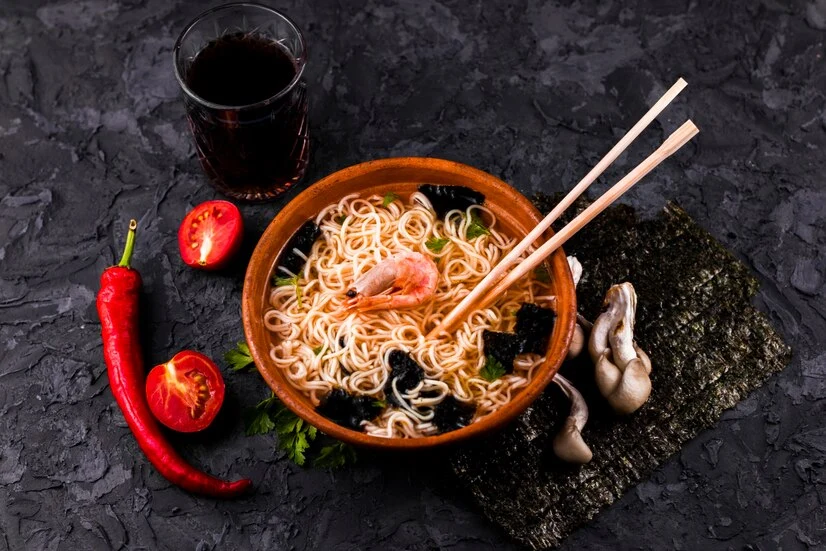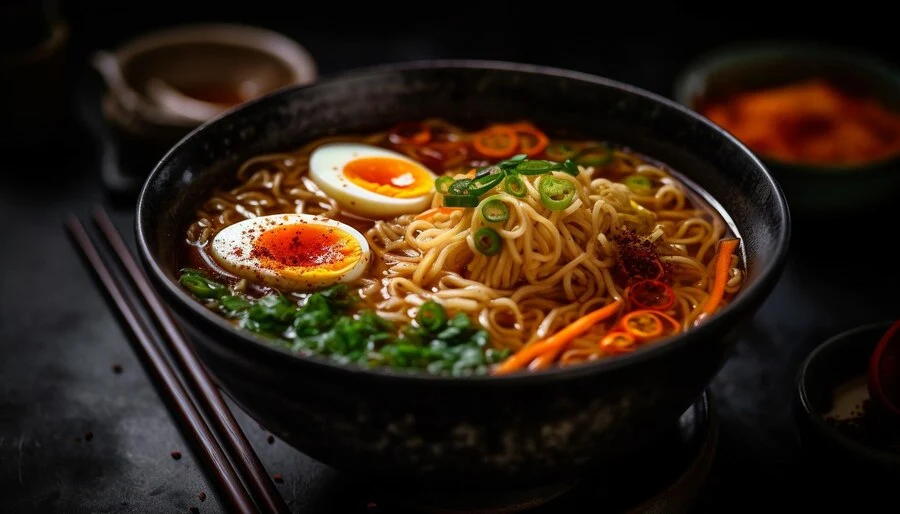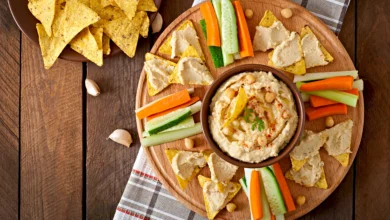Gluten-Free Ramen Noodles: Everything You Need to Know
Today we are going to discuss Gluten-Free Ramen Noodles. Ramen is one of the most loved comfort foods around the world Tokyo streets to kitchen countertops-is are impressively versatile. However much one deems noodle soup for dinner as comforting as can be, whether a lover of traditional shoyu broth, spicy miso, or noodle stir-fry, ramen offers endless possibilities. However, for those who suffer from gluten intolerance or celiac disease, gulping down a bowl of noodles proves challenging because traditional ramen noodles contain gluten.
Thankfully, gluten-free ramen noodles have become freely available; thus, more people can indulge in this iconic dish without fear of associated health problems with gluten. We will discuss, in this article, the world of gluten-free ramen noodles: ingredients and types of gluten-free ramen, the best brands, and recipes.

What is Ramen?
Ramen is one of the Japanese noodle soups that has gained followers from every corner of the globe. Wheat-based noodles comprise the traditional ramen, but it is served in a delicious savoury broth – be it soy-based shoyu or rich, creamy tonkatsu. It can be topped with anything from sliced pork and soft-boiled eggs to bamboo shoots and green onions to make it a meal in a bowl.
Popularity of Ramen
It has gained wide popularity because of its flexibility, taste, and cultural connotations. Ramen is no longer just an easy meal in itself, but rather it’s a dish prepared by great chefs to serve their gourmet versions. Ramen is essentially a wheat-based product, but nowadays, gluten-free ramen is also on the rise, so many more can enjoy this scrumptious delicacy.
Why Gluten-Free Ramen is Important
To the gluten intolerant and people with celiac disease, ramen noodles in their traditional form have no room since they contain wheat. With the emergence of gluten-free ramen noodles, they could now enjoy ramen without its undesirable effects. Gluten-free ramen is an emerging need globally in the consumption of gluten-free foods that will allow more people to enjoy their favourite foods safely.
Understanding Gluten and Gluten-Free Diets
To understand gluten-free ramen noodles, let’s first dive a little into what gluten is and why avoiding it is important for certain individuals.
What’s Gluten?
Gluten is a protein in wheat, barley, rye, and their products. Gluten acts as a binder that gives dough its elasticity and ability to rise. It is not harmful to most people. Nevertheless, individuals with celiac disease or with gluten sensitivity should shun it for them to remain healthy.
Gluten-Containing Foods
Gluten occurs naturally in several food products. Some of these are:
- Bread, pasta, and cereals
- Cakes, cookies, and pastries
- Soy sauce and numerous processed foods.
- Beer and malted foods
How Gluten Works on the Body
For people suffering from celiac disease, gluten can precipitate an autoimmune reaction that causes damage to the lining of the small intestine, and this may lead to malabsorption of nutrients. Their symptoms may include bloating, diarrhoea, and fatigue, but if it is not treated, serious health problems can come along. Those with gluten intolerance or sensitivity will have similar symptoms but without the autoimmune reaction.
What Is Gluten-Free?
It is a diet that confines or excludes all forms of gluten from one’s diet. In this case, these food products need to be prepared using no wheat, barley, or rye, and they need to be prepared in an environment devoid of glutens.
Gluten-Free Certification
There are several gluten-free products that have reliable certificates from organizations like Gluten-Free Certification Organization, or GFCO. As long as any product carries less than 20 ppm of gluten, then it is considered safe for a person suffering from celiac disease.
Why Gluten-Free for Celiac Disease
A gluten-free diet is an essential part of treatment for celiac disease. Such small amounts of gluten may cause severe diseases, so these gluten-free products need to be found in the daily routines of the patient.
What Disqualifies the Traditional Ramen as Gluten-Free?
The basic components of traditional ramen consist of wheat and are, consequently, not gluten-free.
Traditional Ramen Noodles: Ingredients Containing Gluten
The traditional ramen noodles consist of wheat flour, water, salt, and kansui. Alkaline water, kansui is what gives noodles their chewiness. As wheat flour is the primary ingredient used in noodles, the noodles cannot be allowed in a gluten-free diet.
Grains as the Main Backbone for Authentic Ramen
Grains make up the majority of the traditional ramen noodles. Cooked grains soak in the flavour and chewiness to create the noodles. While being very appealing in flavours, grain-based noodles highly threaten people with gluten intolerance.
Why Ramen Broth May Contain Gluten
In addition to the noodles themselves, some ramen broths contain gluten. Soy sauce is a common ingredient in shoyu based it’s often produced with wheat. Therefore it would be necessary to choose gluten-free broth bases and soy sauce alternatives in order to prepare gluten-free ramen.
Gluten-Free Ramen Noodles: An Introduction
Fortunately, it is easy enough to substitute gluten-free ramen noodles in all of your favourite ramen dishes, as gluten-free ramen noodles are available. Gluten-free ramen noodles can be made with alternative grains that are not gluten-rich, such as rice, buckwheat, or sweet potato.
How Gluten-Free Ramen Noodles Differ
What is different in gluten-free ramen and other ramen noodles is the type of flour used in making noodle dough. Gluten-free ramen noodles use naturally gluten-free grains or starches instead of wheat. Alternative noodles come out a little differently in texture and flavour, but they are not bad enough to spoil the true ramen experience.
Ingredients in Gluten-Free Ramen Noodles
Ramens made from gluten-free noodles can be prepared from numerous grains and starches. These include some of the most popular alternatives:
Rice Flour-Based Ramen
Rice flour is a common gluten-free alternative used in making ramen noodles. Rice-based ramen is soft, neutral in flavour, and has become one of the most popular choices for mild noodle variety that pairs well with any soup.
Buckwheat-Based Ramen
Buckwheat is naturally gluten-free, and commonly used in Japanese soba noodles. Buckwheat-based ramen noodles have a nutty flavour and also tend to be firmer than rice noodles. Be careful, however, as not all soba noodles are wheat-free; so, if looking for a gluten-free noodle, look for 100 per cent buckwheat noodles.
Other Gluten-Free Grains Used
Other grains and starches are used to make gluten-free ramen noodles such as:
- Sweet potato starch
- Shirataki (konjac yam) noodles
- Corn flour
- Quinoa flour
Each of these grains supplies a distinct texture and flavour, so there is much diversity for the gluten-free aficionados of ramen.
Types of Gluten-Free Ramen Noodles
Gluten-free ramen noodles come in varied forms, which are characterized by different textures and culinary possibilities. Here are some of the most common types of gluten-free ramen noodles:
Rice Ramen Noodles
Rice ramen noodles are mainly composed of rice flour and water. These are very light, chewy, and easy to cook. They tend to be softer compared to wheat-based ramen but absorb the flavours of the broth very well.
Buckwheat (Soba) Noodles
While soba noodles are usually made from buckwheat, many soba noodles actually contain gluten. For gluten-free options, look for 100% buckwheat soba noodles, which are firmer and have a more earthy flavour. Buckwheat soba is a great option when you’re after a denser noodle with a fuller flavour.
Sweet Potato Noodles
Made from sweet potato starch, these translucent noodles offer a chewy and bouncy texture. Sweet potato noodles often feature a variety of Korean and Chinese cuisines though can easily be adapted for ramen dishes. They’re naturally gluten-free and low in calories.
Shirataki Noodles
Shirataki noodles are another noodle that is made from the konjac yam, which is 100% gluten-free. They contain very few calories and gelatinous texture. Shirataki is best suited for a person who wants his or her ramen noodles lighter.
Konjac Noodles
Similar to shirataki, konjac noodles come from a plant called konjac and can be a good addition to a diet that is free from gluten since it does not have gluten content. The texture is chewy, and typically they are used in Japanese dishes. They don’t contain carbs, which makes them suitable for diets that are gluten-free and low on carbs.
Cooking Gluten-free Ramen Noodles
There are a few techniques and tips in cooking gluten-free ramen noodles which will ensure you get your noodles right, both in terms of texture and flavour.
How to Cook Gluten-Free Ramen Noodles Right
Glut-free noodle ramen has the disadvantage of being slower to cook than the usual wheat noodles. Glut-free noodles lose their firm and chewy texture when overcooked, thus stay safe and strictly follow the package instructions for boiling. Boiling Times for Different Kinds of Noodles.
Type of Gluten-free noodle Cooking time
- Rice noodles 3-5 minutes
- Buckwheat noodles 5-7 minutes
- Sweet potato noodles 7-10 minutes
Shirataki noodles: Just a few minutes, as they’re already pre-cooked
How to Steer Clear of Soggy Gluten-Free Noodles
To steer clear of mushy noodles, it pays to:
Avoid overcooking: Always check the noodles a few minutes before the packaged cooking time is up
Rinse noodles after cooking: For some gluten-free types like rice and sweet potato, rinsing them under cold running water after they’ve been boiled will make them less mushy
Tips for Making the Flawless Gluten-Free Ramen
Some other tips for a delicious bowl of gluten-free ramen are:
- Use the right broth Those broth and miso have to be gluten-free.
- Add all your toppings just before serving. This will keep your ramen moist, flavorful and not mushy. For instance, soft-boiled eggs, green onions or vegetables to accompany ramen
- Season carefully. And add that depth of flavour with gluten-free soy sauce or tamari.
Well-known Brands Offer Gluten-Free Ramen Noodles
There are many brands trying to meet the population’s growing needs for gluten-free ramen noodles. Here are some of the top gluten-free ramen noodle brands:
Lotus Foods Gluten-Free Ramen Noodles
Lotus Foods is one of the leading brands when it comes to gluten-free ramen. The company offers different kinds of noodles, which can be either made from brown rice, millet, or buckwheat. These products come in wide choices in terms of flavour and texture as a healthy food substitute.
King Soba Gluten-Free Ramen
King Soba is an organic and gluten-free noodle manufacturer. It offers buckwheat, rice, and quinoa-based ramen. Their noodles are solid, strong, and hence always in demand from ramen lovers who also adhere to a gluten-free diet.
Explore Cuisine Organic Ramen Noodles
Explore Cuisine offers gluten-free noodles that consist of organic rice and lentils. These are high in protein and fibre and are the healthier choice in gluten-free rams.
Miracle Noodle Ramen
The Miracle Noodles are special as they are created from shirataki. These are low-calorie and low-carb noodles, and their gluten-free ramen noodles are designed for those who can’t compromise on the taste or texture when taking a healthier turn.
Gluten-Free Noodle Cup Options
For those on the go seeking a fast, easy meal, several gluten-free ramen cups can be found in stores. The busy-to-go person who wants a fast, gluten-free meal is being catered for by brands such as Dr McDougall’s through convenient cup formats with their gluten-free ramen.
How to Ensure That Your Ramen Broth is Gluten-Free
The noodles are significant, but the broth in ramen itself can serve as a source of gluten. You have to get the right broth ingredients so that your ramen is completely gluten-free.
How Ramen Broths Might Be Gluten Hiding
Ramen broths might hide sources of gluten in the following ways:
Soy sauce: Most run-of-the-mill soy sauces contain wheat and will thus have to be replaced with tamari or gluten-free soy sauce
Miso paste: Many brands of miso include barley in their ingredients so make sure to check the label for gluten-free
Thickeners: Some ramen broths are thickened with wheat flour or other sources of gluten.
Best Gluten-Free Broth Bases for Ramen
Here are some great choices for making a super good gluten-free ramen broth:
Miso Broth
Gluten-free miso paste is a fantastic base for a rich, umami-flavored ramen broth. Consider brands that actually explicitly declare the gluten-free status of their miso.
Gluten-Free Soy Sauce and Tamari Alternatives
Substitute traditional soy sauce with tamari or coconut aminos, which are gluten-free tamari-like alternatives, for flavour in your ramen broth without any gluten. These alternatives still convey the deep, savoury flavours you need for a great ramen base.
Gluten-Free Ramen Recipes
Once you have the gluten-free ramen noodles and broth, it’s a fun time with some recipes. Here are some gluten-free ramen recipes that will satisfy any appetite:
Classic Gluten-Free Shoyu Ramen
- Gluten-free ramen noodles
- Gluten-free tamari
- Chicken broth
- Soft-boiled eggs
- Scallions
- Nori sheets
This classic shoyu ramen boasts a deep soy sauce-flavoured broth using gluten-free tamari, chewy gluten-free noodles, and traditional toppings.
Spicy Gluten-Free Miso Ramen
- Gluten-free ramen noodles
- Gluten-free miso paste
- Chicken or vegetable broth
- Chili paste
- Ground pork
- Bok choy
Malicious: Put a rich, savoury flavour profile on gluten-free ramen by using miso and chili paste.
Vegan Gluten-Free Ramen
- Vegetable broth
- Tofu
- Gluten-free miso paste
- Shiitake mushrooms
- Spinach
This vegan rendition of ramen uses gluten-free noodles and hearty vegetable broth, packed with tofu and mushrooms.
Chicken and Vegetable Gluten-Free Ramen
- Gluten-free ramen noodles
- Chicken broth
- Cooked chicken breast
- Carrots, mushrooms, and bok choy
- Gluten-free tamari
This comforting soft chicken and vegetable ramen, cooked in a savoury broth, can be quite a healthy, satisfying gluten-free meal.
Gluten-Free Ramen Stir-Fry
Ingredients:
- Gluten-free ramen noodles
- Soy-free sauce or tamari
- Mixed vegetables (peppers, carrots, zucchini)
- Chicken or tofu
This ramen noodle is transformed into a stir-fry where you fry it with vegetables and protein and serve it smothered with gluten-free tamari sauce.
Benefits of Gluten-Free Ramen Noodles
The consumption by those afflicted with celiac disease or gluten intolerance is safe, but other advantages are seen in gluten-free ramen noodles.
Gluten-Free Ramen for Celiac Disease
Gluten-free ramen noodles allow those suffering from celiac disease the pleasure of being able to consume their desired foods without jeopardizing their health. The noodles were specifically designed to be safe for consumption by those who have to avoid them.
Health Benefits of Gluten-Free Ramen Noodles
Most of the gluten-free ramen noodles are derived from nutrient-rich grains, including rice and buckwheat. Thus, some of them can offer a proper quota of essential nutrients, like fiber, protein, and vitamins. Additionally, most noodles from raw materials, such as sweet potatoes or shirataki, have fewer calories and carbs.

Differences between gluten-free Ramen noodles and regular Ramen noodles.
The gluten-free ramen noodles are different from the traditional old-school ramen noodles in some aspects:
Texture, Taste Comparisons
The texture of gluten-free noodles is certainly different from its traditional counterparts. They are actually softer, even though sometimes there is still just a little bit of chew in some noodles. When it comes to taste, gluten-free noodles are typically more neutral, which helps make the broth and toppings the stars of the dish.
Is Gluten-Free Ramen Noodle Satisfying?
Although not as good as ramen served with wheat noodles, gluten-free noodles are very rewarding with adequately flavoured broth and tasty garnishes.
Tips on Where to Find Gluten-Free Ramen Noodles
Here’s where you can buy such ramen noodles:
Gluten-free ramen noodles.
Shopping for Gluten-Free Ramen at Grocery Stores
The gluten-free noodles by ramen can mostly be found in the speciality or health food section of most grocery stores. So, the brands that you could consider in this regard are Lotus Foods and King Soba.
Gluten-Free Ramen Noodles: Available on Online Sites
Amazon, Thrive Market, and many other speciality gluten-free stores all carry readily available gluten-free ramen noodles.
Conclusion
Since the advent of gluten-free ramen noodles, those intolerant to gluten can now enjoy and truly experience the ramen culture without fear. With the options on the table, ranging from rice-based, buckwheat-based, or even sweet potato noodles, you can have your perfect ramen meal at home or buy this at speciality stores. Whether celiac disease, gluten intolerance, or just a healthy noodle substitution in general, gluten-free ramen noodles hold flavour, nutrition, and versatility without ever losing flavour.
Also Read: Is Crispix Gluten-Free? Gluten-free Crispix alternative
FAQ’s
Do all gluten-free noodles qualify for ramen?
Not all gluten-free noodles qualify for ramen; some are best for other dishes. Rice or buckwheat noodles are most often used in ramen.
Is gluten-free ramen healthier than regular ramen?
Gluten-free ramen can be as healthy, especially when these noodles come from grains rich in nutrients, like rice or buckwheat.
How do I make sure that the ramen broth I make is gluten-free?
To be sure your broth does not contain gluten, use gluten-free soy sauce substitutes like tamari and avoid thickening agents made from wheat.
What are the most common gluten-free toppings for ramen?
Some of the most common gluten-free toppings are vegetables, soft-boiled eggs, nori (seaweed), tofu, and chicken.
Can one make homemade gluten-free ramen?
Absolutely! All you need to do is use gluten-free noodles, and with proper preparation, ensure that your broth as well as your toppings are gluten-free.



